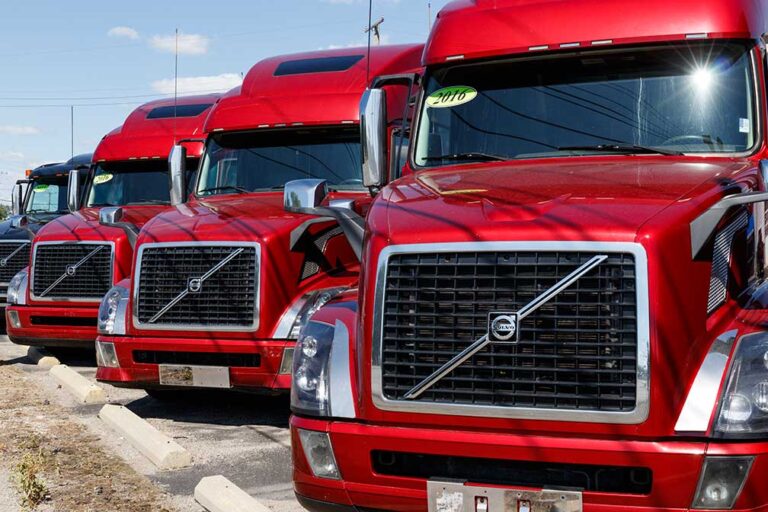As expected, October was another strong sales month for new Class 8 trucks in the U.S.
Manufacturers reported sales of 20,859 trucks, according to data received from Wards Intelligence. While that number reflects a 4.4% drop from September 2024 sales — and 2.6% lower than October 2023 — it was still strong, given the overcapacity situation in the freight market.
Pre-buying in advance of the Environmental Protection Agency’s (EPA) 2027 mandates for tougher fuel mileage and emissions standards is the most likely reason for the month’s strong sales.
With those 2027 mandates, the added technology, along with the increased warranties required, is expected to drive up the cost of a new Class 8 truck by $30,000 or more. In the past, the truck buying market has reacted to such mandates by purchasing extra equipment before the changes go into effect in order to mitigate the cost increases and maintenance issues sometimes caused by the new technology.
Vocational truck sales on the rise
During this cycle, buyers of vocational trucks seem to be jumping aboard the pre-buy bandwagon. Most vocational trucks (those fitted with dump, concrete, trash or other bodies rather than a fifth wheel for pulling trailers) tend to remain in fleets longer than their over-the-road (OTR) counterparts. Newer equipment is a larger selling point to OTR drivers who remain in their trucks during non-working hours.
“Vocational truck orders totaled 9,500 units (North American market) and, after last month’s surge, suggest the potential for vocational market queueing ahead of EPA’27 and GHG-3,” said Kenny Vieth, president and senior analyst at ACT Research.
And there’s another incentive for vocational buyers to buy new equipment now — government money.
“Vocational truck buyers not only have a willingness to get a head start on refreshing their fleet but a clear ability as the $2 trillion in stimulus continues to be deployed,” Vieth said, referring to the Infrastructure Investment and Jobs Act, signed into law in November 2021, the CHIPS and Science Act (August, 2022) and the Inflation Reduction Act (August, 2022).
All together, these three bills make more than $2 trillion available for construction and other projects.
October’s orders for new trucks will fill build slots well into 2025 — and could help alleviate the overcapacity problem that has held freight rates down.
How and why?
As build slots are taken by vocational trucks, fewer slots are available for OTR equipment, reducing the number of new trucks added to the nation’s fleet. Fewer trucks means shippers must compete for trailers to haul their product, which generally results in rate increases.
On the used Class 8 truck market, ACT reported that sales in October were 29% higher than in September and 28% higher than in October 2023.
The price of the average used truck sold increased by 2%, while the average age and the odometer mileage both declined. The median price of used trucks was 12% lower than October 2023, certainly due to the increased inventory available.
On the new truck market, an increase in orders for vocational trucks is likely a big reason for the surge in sales at Daimler-owned Western Star. In November 2023, the company announced its intention to expand production of its lineup.
OEMs report in
Western Star reported record sales of 8,334 in 2023, a total they surpassed in October 2024 with sales of 1,117 to bring their total to 9,215 with two months left in the year. For the year to date, the company is 37.3% ahead of last year’s sales pace in a market that as a whole declined 11.4%.
Of course, Western Star has a much smaller footprint than sibling company, Freightliner, which reported sales of 7,863 in October, down 2.4% from September sales but an increase of 18.2% over October 2023.
Western Star’s 4.6% of the new Class 8 market pales in comparison to Freightliner’s dominant 36.4%, but its share has grown 1.6% from last year’s pace — while Freightliner’s has shrunk.
The two PACCAR companies, Kenworth and Peterbilt, have stayed ahead of the market trend.
Kenworth reported sales of 3,013 in October, down 5.1% from a month earlier and down 18.2% from October 2023. Peterbilt’s 3,119 sold was 1% better than September but still down 13.6% from October 2023. Still, for the year to date, Kenworth sales are 5% lower than last year and Peterbilt’s numbers are down 3.6%, the lowest declines among all manufacturers. Both have picked up market share this year, Kenworth grabbing 1.0% more to hold 15.4% and Peterbilt taking 1.3% to total 15.9%.
International, which ditched the “Navistar” moniker to return to its roots, has seen the biggest loss in market share for 2024, losing 3.4%. October sales of 2,533 were down 6.4% from September and 10.6% from October 2024. The company that in 2009 topped Freightliner for the largest share of the U.S. Class 8 market today holds only 10.8% of it. For the year to date, International sales lag 32.8% behind last year’s sales, the largest decline of all major manufacturers.
Volvo reported sales of 1,840 Class 8 trucks in October, down 26.8% from September sales and down 16.8% from October of 2023. For the year to date, Volvo holds 10.2% of the new truck market, actually gaining 0.3% over last year’s pace despite a 9.1% decline in sales.
Tiny Hino has been making inroads into the market with its XL8 day cab offering, reporting sales of 11 units in October after selling 19 in September. For the year to date, the company is up to 155 units, good for one tenth of a percent of the market. Hino is much more well known in the Class 4-6 markets and is primarily used in local and regional operations.
Truck sales impact freight rates
At this point, truckers are continuing to keep an eye on freight rates, hoping that a turn upward will arrive sooner rather than later.
While the performance of the U.S. economy will have a bearing on the amount of available freight, the number of trucks in the national fleet will go a long way toward determining whether rates rise or remain depressed going into the new year.








